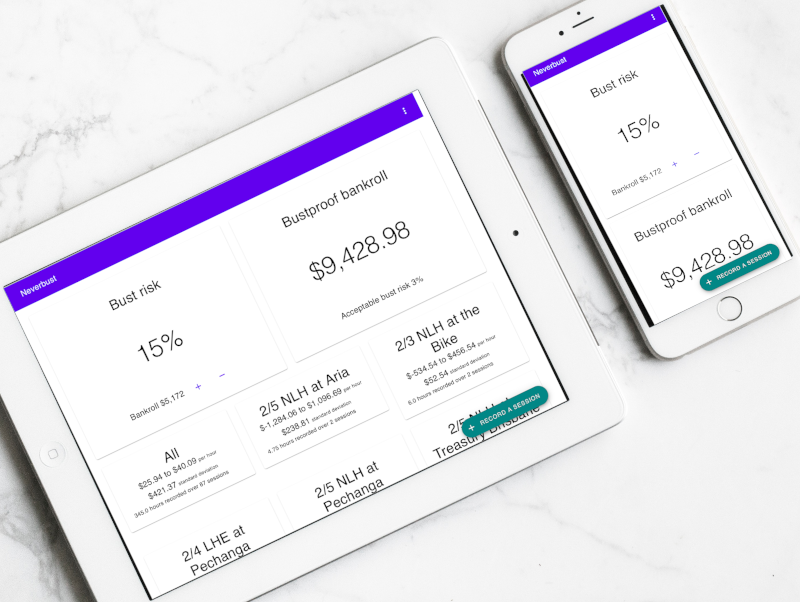Get Total Control of Your Bankroll
Never guess, worry, or stress about your bankroll again.

Neverbust is the Most Advanced Bankroll Manager in the World
What makes Neverbust different is the cutting-edge mathematics it uses to give you answers that are accurate, precise, and specific to your bankroll and your results.
What if you never had to wonder if you were good enough, or properly rolled for the games you play, the way you play, and the people you play against?
Replace guessing, gut feelings, and rules of thumb with precise mathematical precision.
Being Good at Poker is Not Enough
To be a professional, you need a bankroll big enough to survive.
Downswings are inevitable. If you don't have the bankroll to survive them, you will end up on the rail looking for a stake, or worse, a job.
Have you ever wondered?
- Do I have enough money to endure this downswing?
- Am I good enough to outlast this bad luck?
- Am I really a winning player or have I just been lucky?
Manage Your Bankroll
Know your risk of going bust.
Bankroll
Your bankroll is the amount of money you have to play poker. When you win, that money goes in your bankroll. When you lose, it comes out of your bankroll. If your bankroll goes to zero, you can't play poker anymore — you are bust.
Bust risk
Your bust risk is the probability that you will eventually go bust. If you can easily replenish your bankroll, you might accept a twenty or thirty percent chance of going bust. If your bankroll is hard to replace, you may need your bust risk to stay under five percent.
Standard deviation
Standard deviation is a measure of how widely your results fluctuate. Loose play will result in more fluctuation than tight play. Aggressive play will result in more fluctuation than passive play. Wider fluctuations means you will have a higher bust risk or need a larger bankroll.
Risk is inevitable
It is impossible to eliminate risk from gambling — it wouldn't be gambling if you did. To be a successful professional, you must understand, measure, and manage your risks.
Gut Feeling, Rule of Thumb, or Math?
How do you want to manage your career?
The rule of thumb says that for for limit Texas hold'em you should have at least two hundred to three hundred big bets. For no-limit Texas hold'em the estimated acceptable bankroll is twenty to thirty times the amount of money you start the game with.
But there are many reasons those ballpark figures might not work for you.
- You play other games, like pot-limit Omaha (PLO), deuce-to-seven triple draw, mixed games, or anything else.
- You are looser, tighter, more aggressive, or more passive.
- Your opponents are looser, tighter, more aggressive, or more passive.
- Your tolerance for risk is higher or lower.
- You want an accurate, precise, and personalized answer to how large your bankroll should be.
Take the Next Step
Know your minimum bankroll and your risk of going bust.
Already a professional?
Know exactly what your risk of going bust is and how to minimize it.
Want to go pro?
Know exactly how much money you need in your bankroll before you start.
Want to level-up?
Find the games where you make the most money with the least risk.
The Math
Neverbust incorporates the most advanced mathematics ever developed for poker bankroll management. But you don't need to take my word for it.
All of the math and theory underlying Neverbust is laid out in "The Definitive Guide to Poker Bankroll Requirements." If you enjoy reading about advanced application of probability, statistics, and Brownian motion, it is a treat.
If you would rather skip all that stuff but still get the benefits, sign up now.